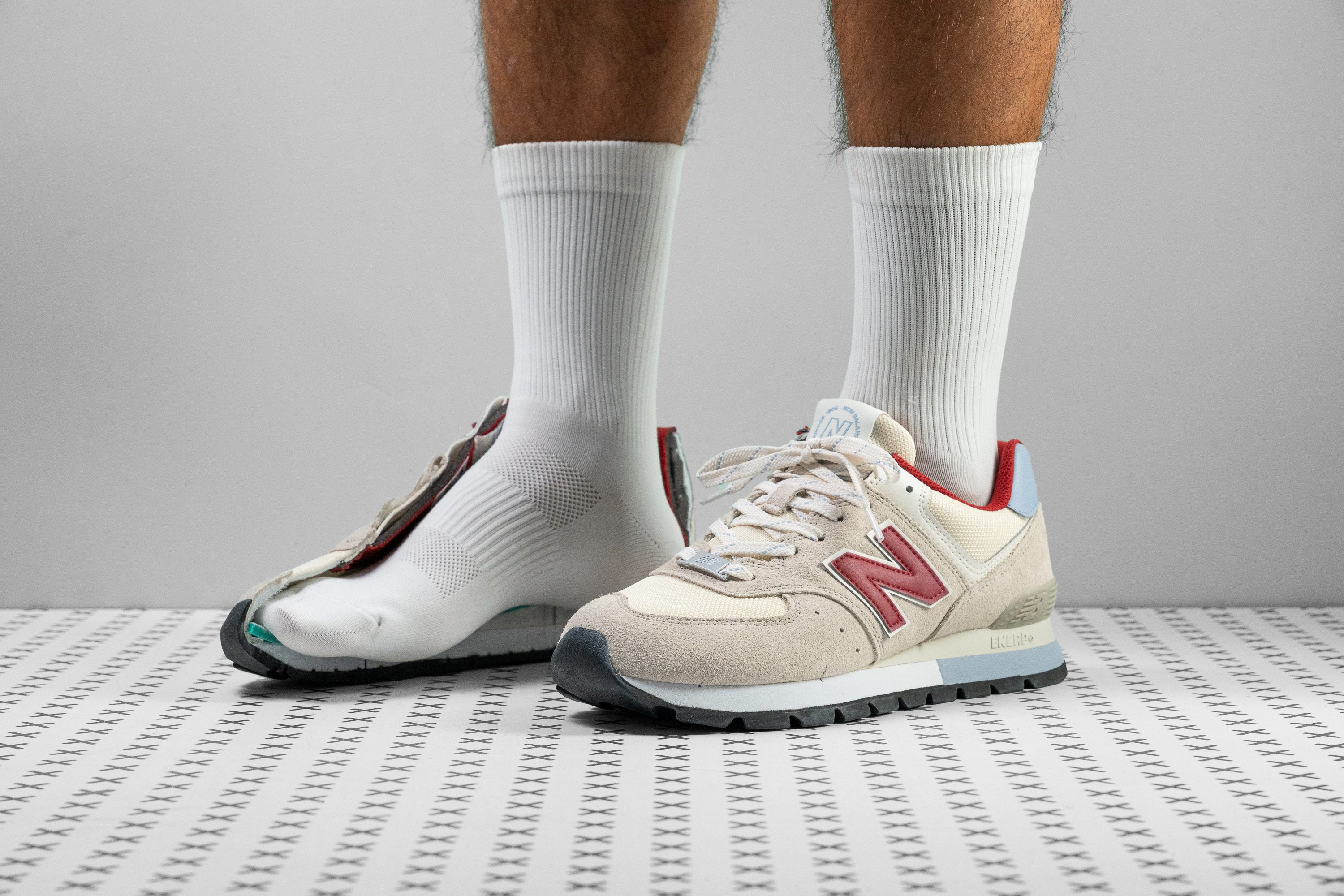Our verdict
- Top pick in best New Balance sneakers
- Top pick in best cheap sneakers
Pros
- Classic NB silhouette
- Budget-friendly
- Suitable for all-day wear
- Real suede
- Highly durable
- Stable and supportive
- Easy to style
- Numerous color options
- Excellent grip on dry and wet
Cons
- Lacks breathability
- Stiff and firm platform
- Tongue shifts a little
Audience verdict
- Top 5% most popular sneakers
Comparison
The most similar sneakers compared
+ + Add a shoe | |||||
|---|---|---|---|---|---|
| Audience score | 90 Good! | 95 Superb! | 92 Great! | 90 Good! | |
| Price | $90 | $130 | $200 | $75 | |
| Style | ClassicDadSporty | Sporty | Retro | RetroSporty | |
| Shock absorption | Moderate | Moderate | Low | High | |
| Energy return | Low | Moderate | Moderate | Low | |
| Traction | High | High | Moderate | High | |
| Breathability | Moderate | Breathable | Moderate | Breathable | |
| Weight lab | 13.9 oz / 393g | 13.2 oz / 373g | 14.7 oz / 417g | 11.3 oz / 319g | |
| Size | True to size | True to size | True to size | True to size | |
| Midsole softness | Firm | Firm | Firm | Firm | |
| Material | Suede | MeshSuede | MeshSuede | MeshSuede | |
| Season | SpringFall | Summer | SpringFall | SpringFall | |
| Inspired from | Running | Running | Running | Running | |
| Width / fit | Narrow | Medium | Medium | Medium | |
| Toebox width | Wide | Medium | Medium | Medium | |
| Leather/suede quality | Real suede | Real suede | Real leather | Real suede | |
| Toebox durability | Decent | Bad | Bad | Decent | |
| Heel padding durability | Decent | Bad | Good | Bad | |
| Outsole durability | Good | Bad | Good | Good | |
| Heel stack lab | 38.2 mm | 34.8 mm | 33.2 mm | 35.2 mm | |
| Stiffness | Moderate | Stiff | Moderate | Moderate | |
| Tongue padding | Thin | Average | Average | Thin | |
| Drop lab | 13.0 mm | 10.0 mm | 11.2 mm | 10.0 mm | |
| Forefoot | 25.2 mm | 24.8 mm | 22.0 mm | 25.2 mm | |
| Removable insole | ✓ | ✓ | ✓ | ✓ | |
| Heel tab | None | None | None | None | |
| Torsional rigidity | Moderate | Moderate | Moderate | Moderate | |
| Heel counter stiffness | Moderate | Stiff | Flexible | Moderate | |
| Reflective elements | ✗ | ✗ | ✓ | ✗ | |
| Closure | Laces | Laces | Laces | Laces | |
| Top | Low top | Low top | Low top | Low top | |
| Ranking | #71 Bottom 41% | #4 Top 4% | #48 Top 40% | #76 Bottom 37% | |
| Popularity | #6 Top 5% | #14 Top 12% | #40 Top 34% | #55 Top 46% |
Who should buy
In our opinion, it's hard to go wrong with the New Balance 574 if you are after the following:
- an affordable classic sneaker
- a very comfortable pair that can get you through the day
- a highly versatile kick that's available in numerous color combinations
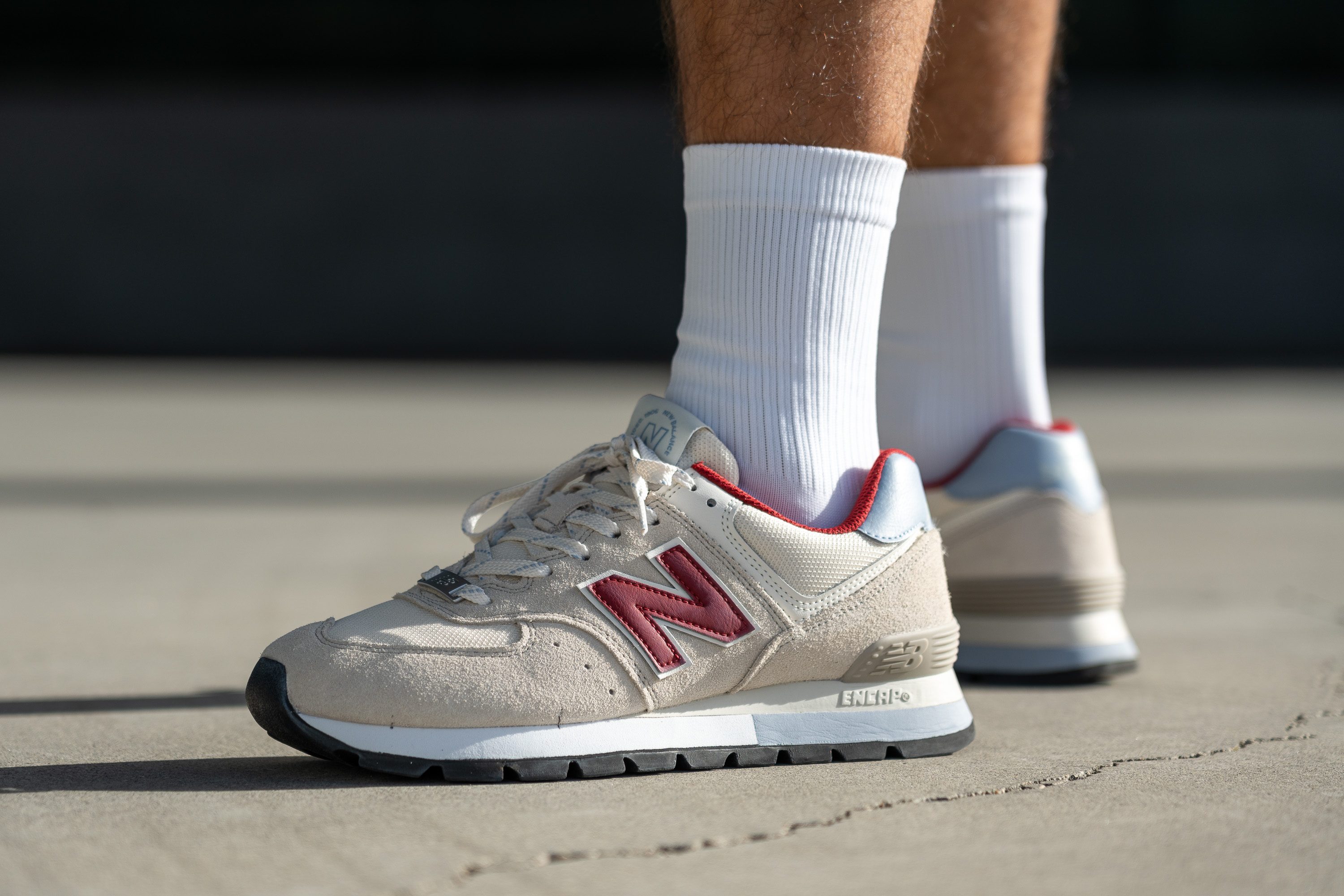
Who should NOT buy
The NB 574 comes with a thick wedge EVA midsole that feels rigid and inflexible. Thus, this kick might feel unforgiving for those who prefer soft and flexible sneakers. As an alternative, you may want to consider the 997H or the more expensive 2002R.
The 574 may also be a disappointment if you are looking for a summer kick. We recommend going for a more breathable option like the PUMA RS-X.
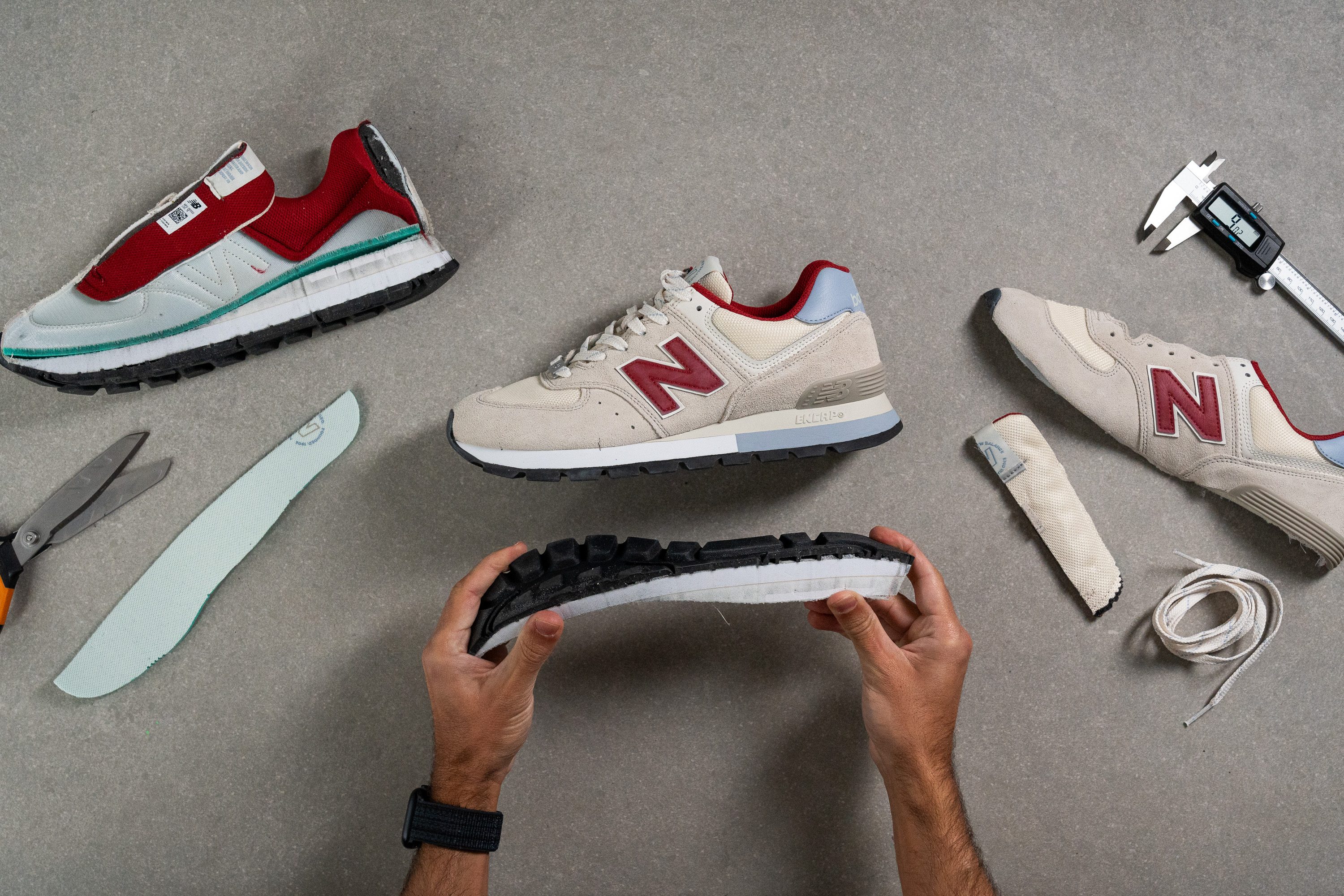
Cushioning
Shock absorption
The 574 wouldn't be one of New Balance's best-selling sneakers if it didn't provide all-day comfort.
Measuring its capacity to absorb the ground forces, our machine recorded an above-average reading of 92 SA. This is a commendable result, considering the shoe's basic cushioning and low price point.
We believe that most people will find this kick protective enough for long hours of walking and standing. But if you're wondering what other affordable NB kicks provide more impact protection, try the 327 (111 SA) or the 237 (109 SA).
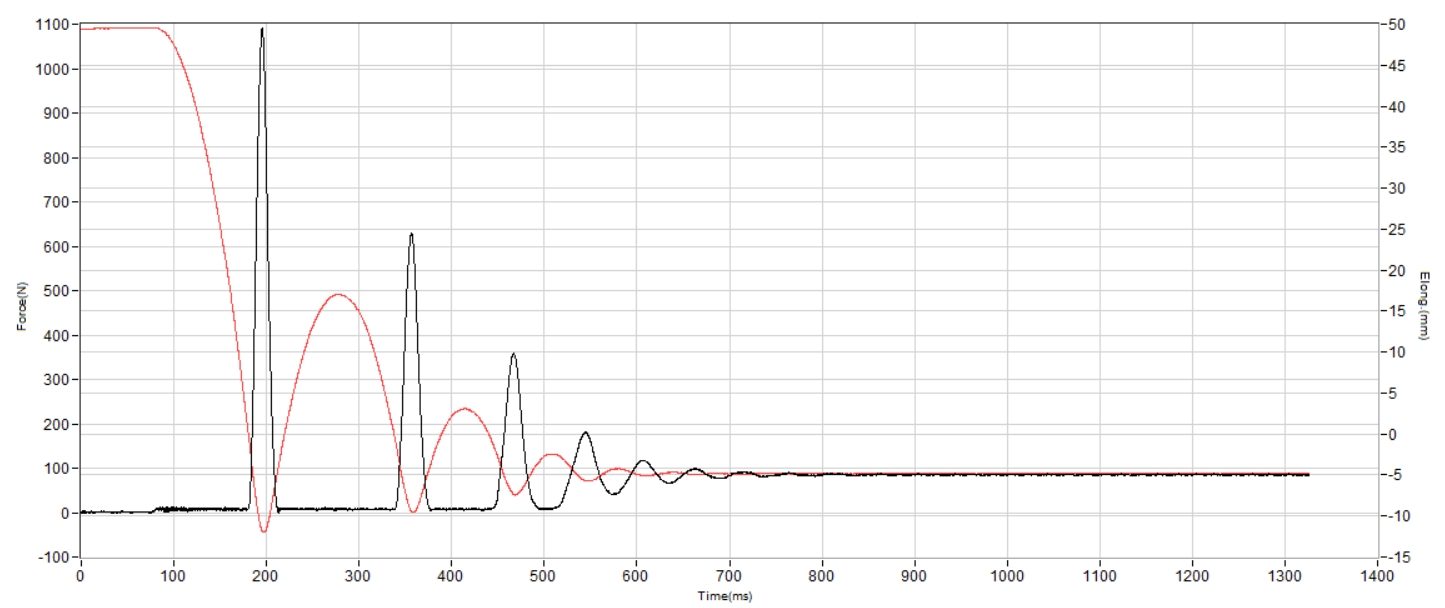
| 574 | 92 SA |
| Average | 89 SA |
Energy return
Originally released in 1988, the 574's cushioning hasn't undergone any major changes for decades!
It feels pretty dead compared to the high-rebound foams of today, which is reflected in its below-average energy return of 43%. The shoe has a flat and stable kind of ride, not a bouncy one.
| 574 | 43.0% |
| Average | 50.2% |
Heel stack
Aside from platform sneakers, the New Balance 574 makes for one of the tallest stacks in our catalog.
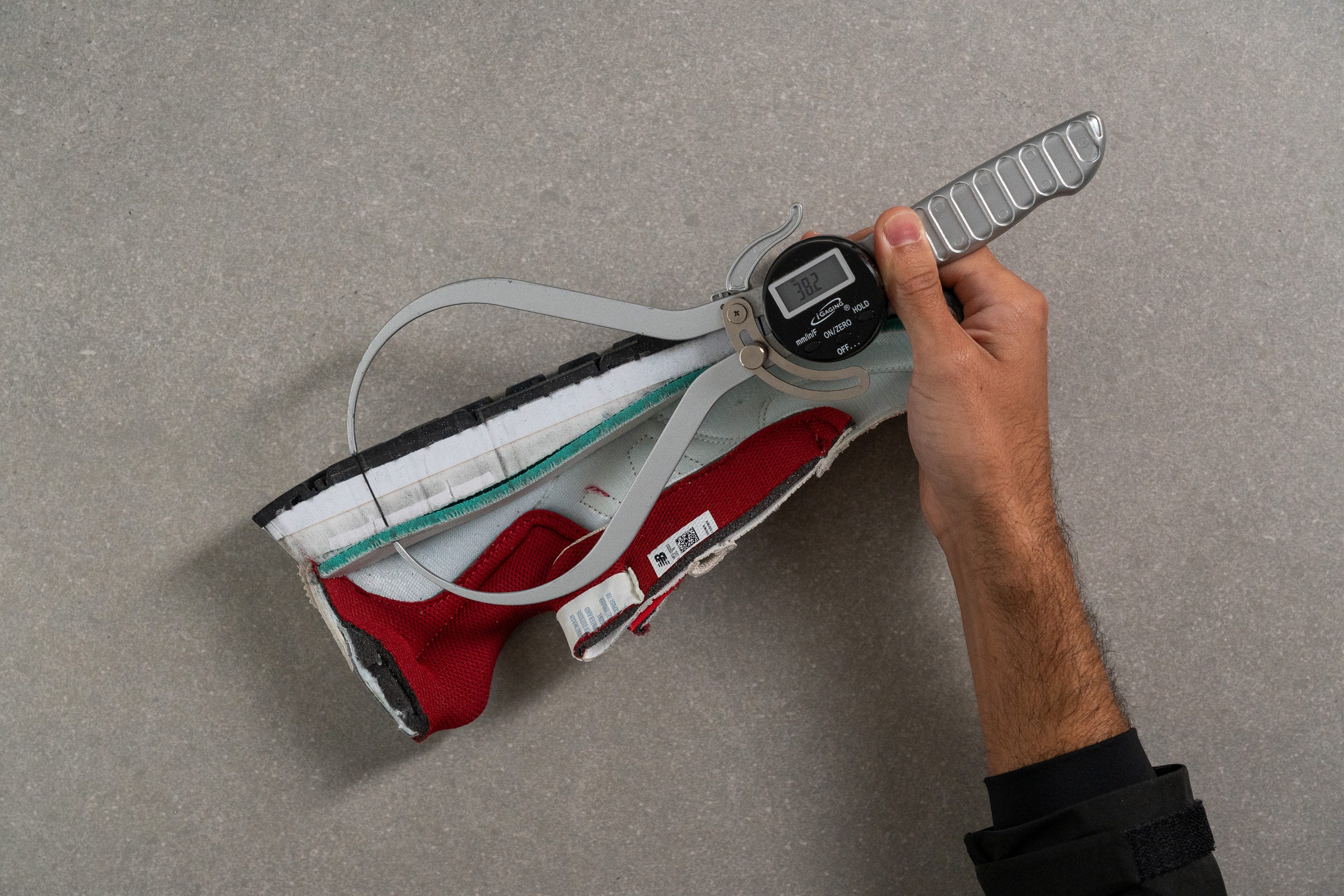
Using a caliper, we measured the shoe's heel height at an impressive 38.2 mm. This is taller than other popular kicks like the Reebok Classic Leather (35.7 mm) or the Adidas Superstar (26.8 mm).
| 574 | 38.2 mm |
| Average | 30.7 mm |
Forefoot stack
In the forefoot, the 574 also proved to be taller than average. We measured the stack height here at 25.2 mm.
The funny thing is that this NB shoe is thicker in the forefoot than some sneakers are in the heel (like the Adidas Samba at 19.3 mm).

| 574 | 25.2 mm |
| Average | 19.5 mm |
Drop
Given the stack difference, we get a 13.0 mm drop in the 574. That's neither good nor bad as it is totally up to the wearer's preference. Some people like to feel their heels elevated while others prefer a more grounded, parallel-to-the-ground experience.
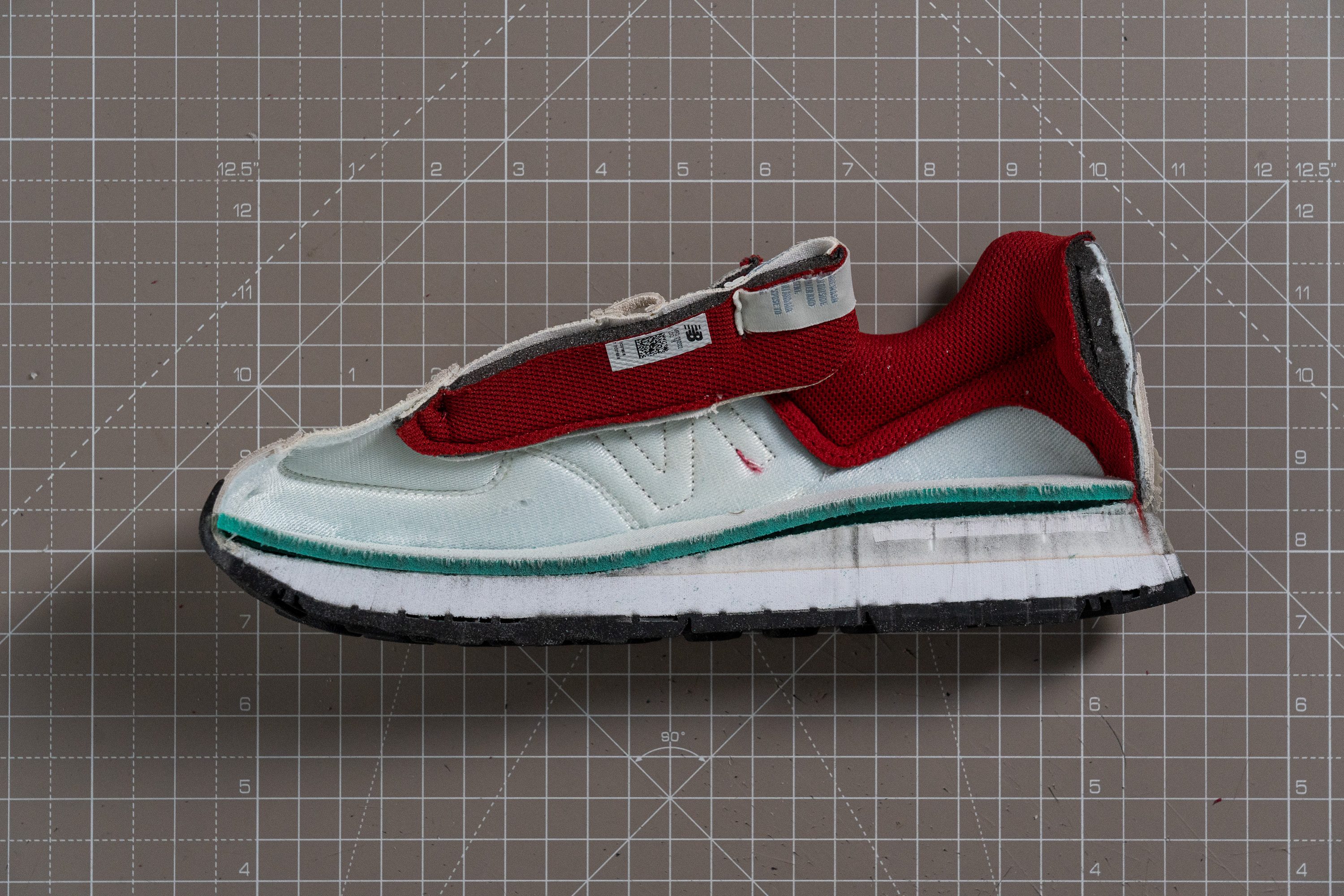
The NB 574 is going to feel slightly elevated in the heel but pretty balanced for most people.
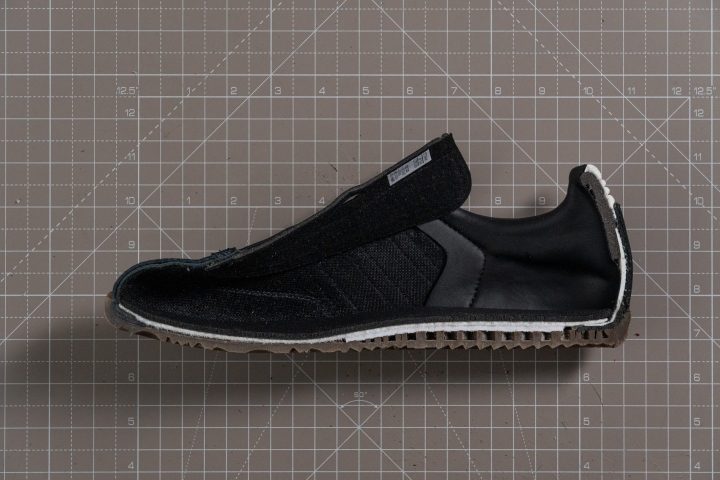
| 574 | 13.0 mm |
| Average | 11.2 mm |
Midsole softness
The 574 sneaker is a perfect example of a thick sole that does not equate to a cushioned sole.
We've got bad news for the fans of plush sneakers - this New Balance offering feels quite firm underfoot.
Using a durometer, we measured the primary foam of the 574 at 44.0 HA. This is some of the firmest we've seen in our lab so far.

| 574 | 44.0 HA |
| Average | 28.6 HA |
Secondary foam softness
You probably noticed that the midsole of the 574 consists of two layers of foam. Thus, we also measured the softness of the top layer (the one closer to the foot).
This foam turned out to be slightly softer than the lower layer. At 29.5 HA, it is actually 49% softer! Although still firm, this top foam at least helps to make landings more pleasurable.
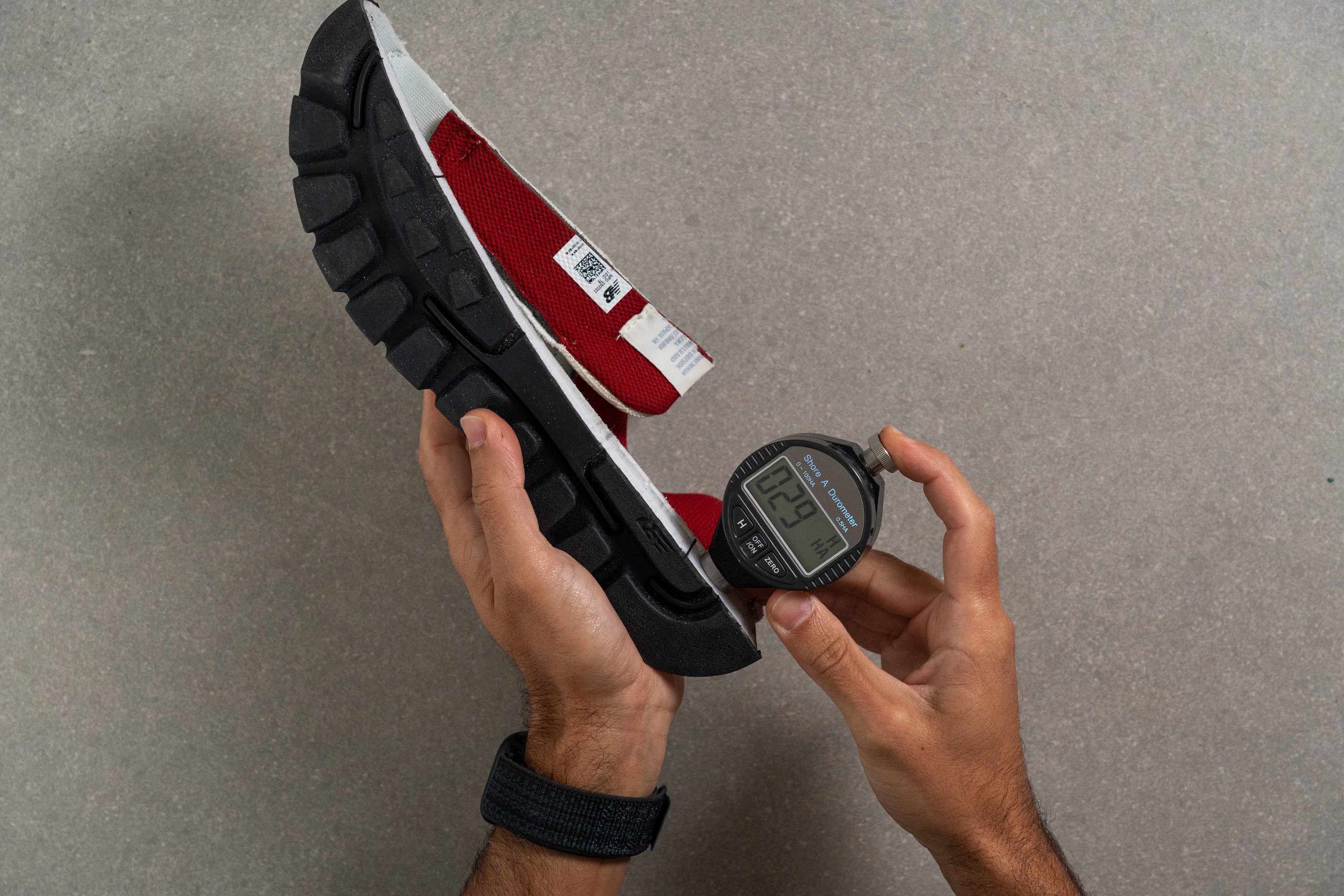
| 574 | 29.5 HA |
| Average | 31.5 HA |
Size and fit
Size
New Balance 574 fits true to size (298 votes).
Width / Fit
A classic NB sneaker with a classic NB fit, the 574 offers a super comfortable and accommodating experience as well as alternative widths to treat all foot shapes.
Having made a mold of the shoe's interiors, we were able to measure its dimensions precisely and compare them to other lifestyle sneakers.
In the widest part, between the big toe and the pinkie, our caliper returned a pretty low reading of 88.7 mm. This can feel snug for a medium-width foot and is definitely too narrow for a broader foot shape. But thankfully, New Balance offers alternative widths for the 574.
| 574 | 88.7 mm |
| Average | 92.5 mm |
Toebox width
In contrast to its narrow ball-of-foot measurement, the 574 offers plenty of wiggle room in the toebox, with its rounded (almost square) shape! At 74.1 mm near the big toe, it is so wide that it exceeds the average by more than 5 mm!

| 574 | 74.1 mm |
| Average | 68.9 mm |
Toebox height
On the downside, some people may find the shoe's vertical space restricting. That's because its toebox height is only 25.4 mm.

| 574 | 25.4 mm |
| Average | 27.8 mm |
Traction / Grip
Traction test
We mimicked a heel strike on wet concrete with the help of a grip testing machine to check if the 574 could generate enough friction to prevent slippage when walking. And it could! With a very high friction coefficient of 0.55, this New Balance shoe is notably grippier than the average sneaker.
As long as you don't try to conquer ice and slush in the NB 574, its outsole will provide great grip for most occasions.
| 574 | 0.55 |
| Average | 0.43 |
Outsole design
Even though its outsole is inspired by trail shoes, the 574's aggressive lugs are merely cosmetic and belong to urban surfaces.
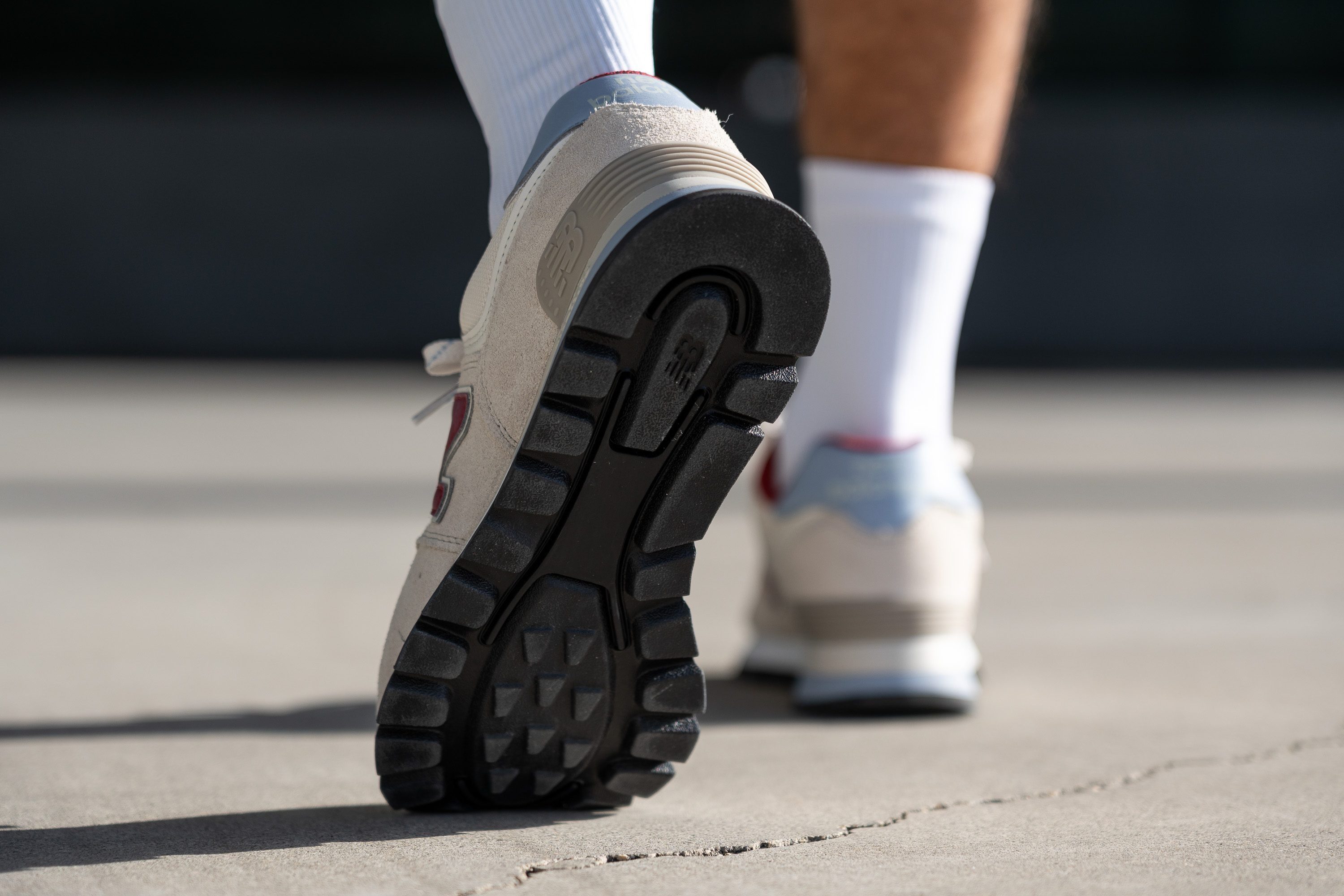
Flexibility / Stiffness
The New Balance 574 is not the kind of sneaker that bends to your will so easily. The shoe feels notably stiffer than minimalist sneakers like the Adidas Gazelle.
To figure out exactly how much stiffer the 574 is, we used a shoe flexing tester to measure the amount of force it takes to bend the shoe by 30 degrees. With an above-average reading of 15.6N, this NB turned out to be a bit more rigid than a typical casual sneaker, but not by much. It still offered a fairly comfortable ride for longer walks.
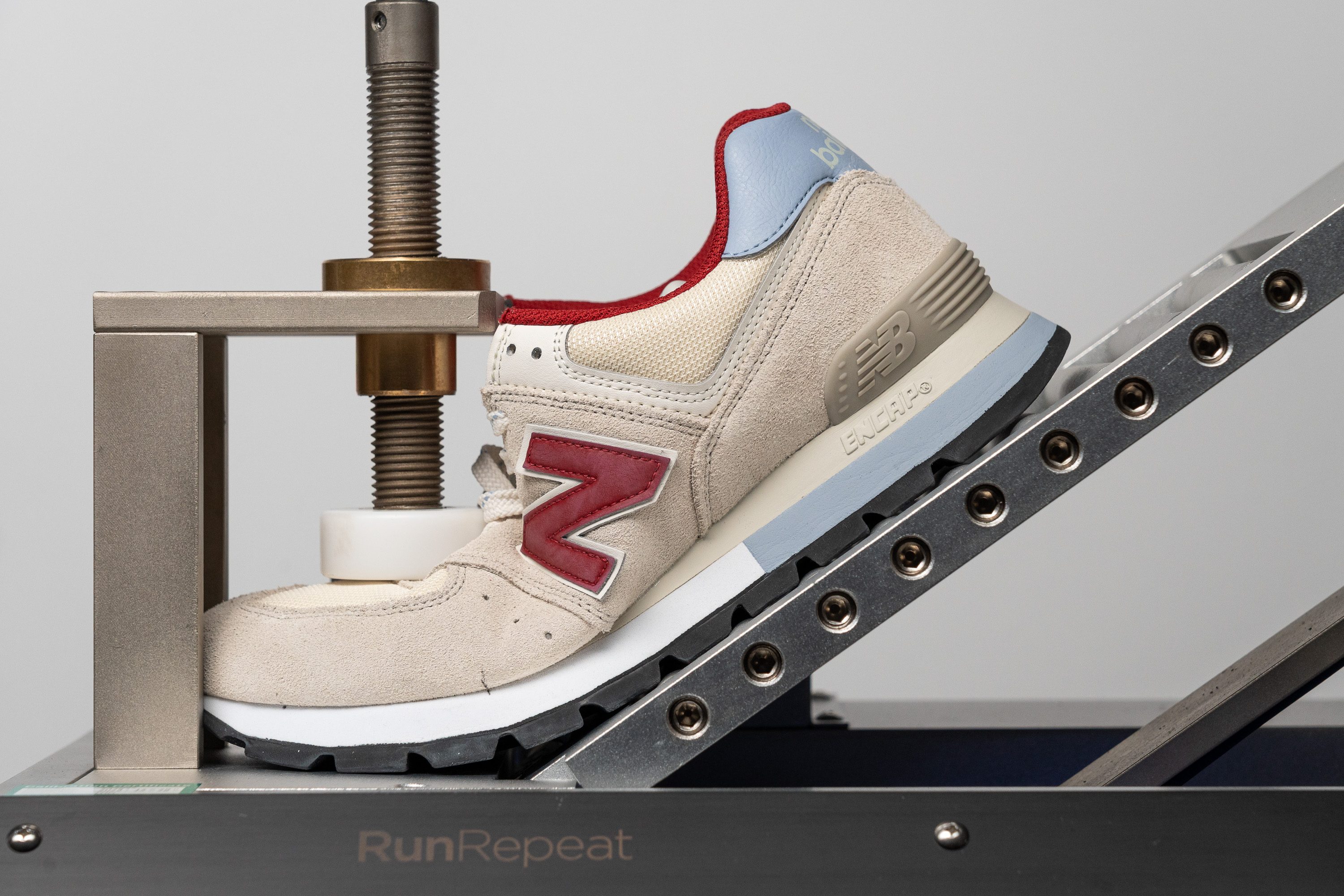
| 574 | 15.6N |
| Average | 13.3N |
Weight
From the look of it, it is only reasonable to think that the New Balance 574 is a chunky boy. And yet, and yet...
The sneaker surprises us once again, this time on a scale. We measured the shoe in a men's US size 9 and found that it weighs 13.9 oz (393g) which is within the average of low-top sneakers.
It exudes a bulky vibe on foot but never drags it down.
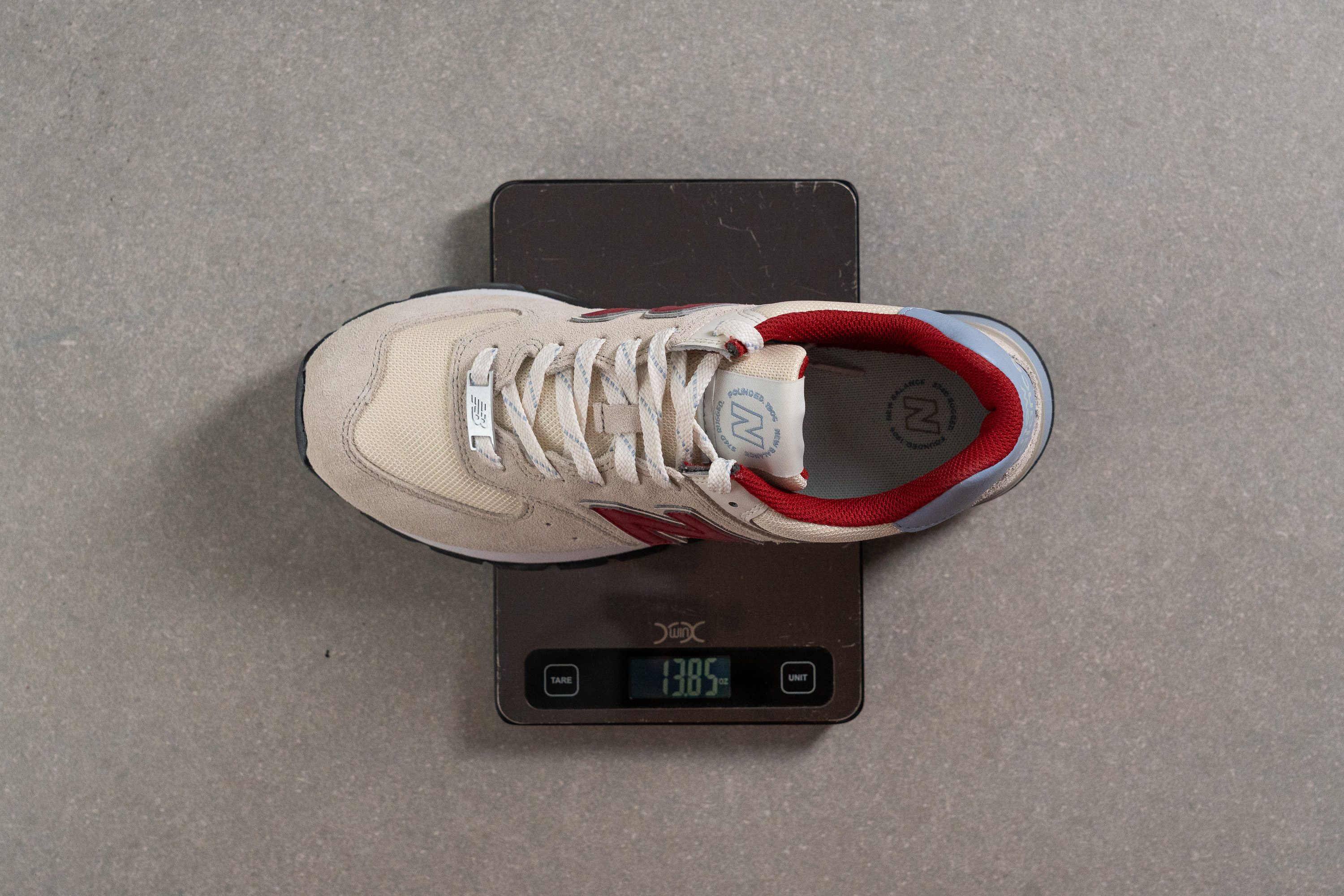
| 574 | 13.9 oz (393g) |
| Average | 13.8 oz (390g) |
Breathability
Donning the New Balance 574 on a hot summer day is a bad-bad idea.
Trying out the 574 in warm temperatures, we couldn't wait to get it off, to be honest. Back in the lab, our experience was confirmed in a breathability test where we pumped smoke through the shoe's upper to see how much of it passed through.
As you can see from the video, ZERO smoke is passing through the shoe's seemingly mesh toebox. Only a little is able to escape through the gaps between the tongue and the shoe quarters.
For that reason, we ended up giving the 574 a lower breathability score of 3 out of 5.
Oh, and never mind the "mesh" panels. These boys are so densely woven that they don't even let the light shine through!
Lookig at the toebox through our microscope...
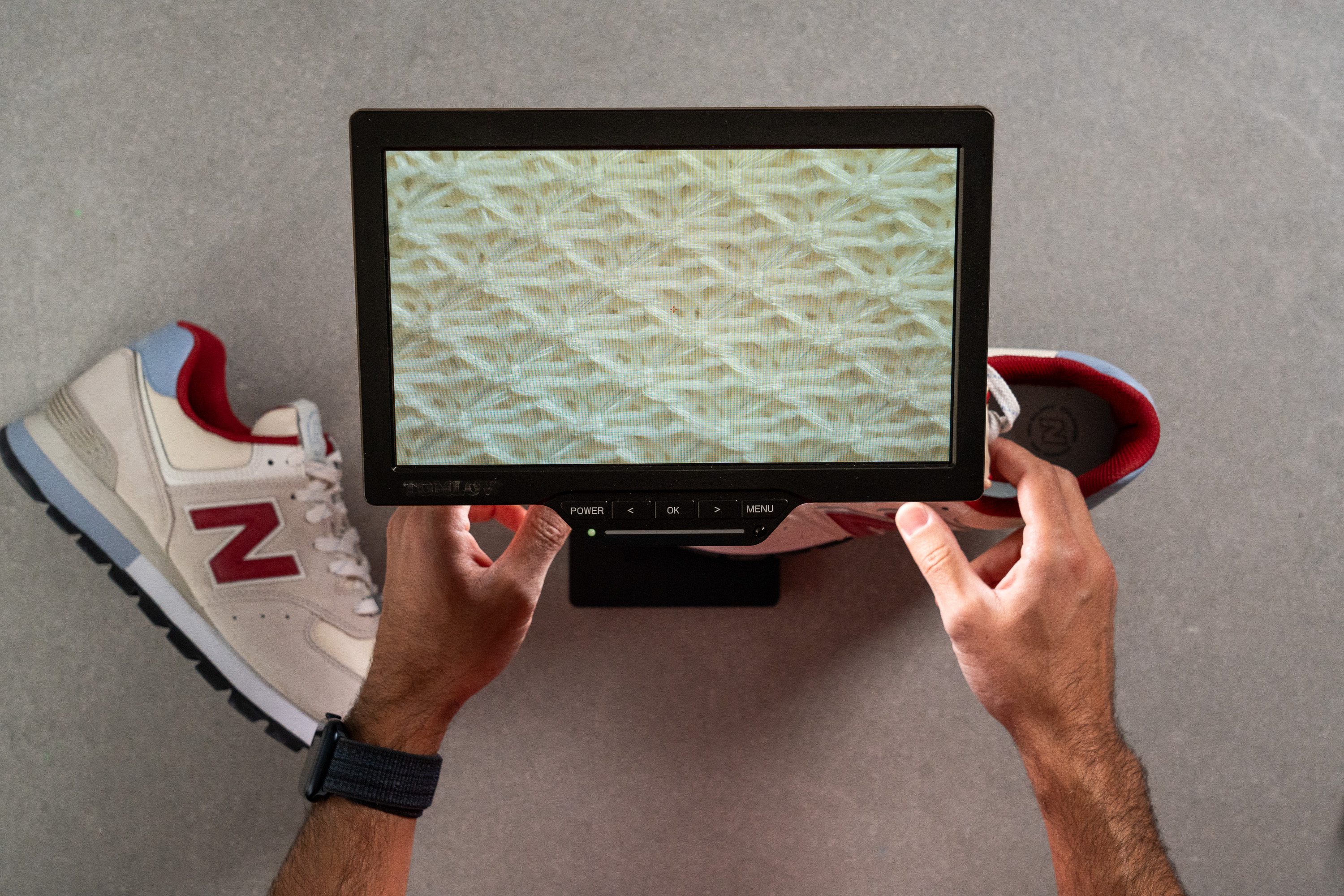
... there are no see-through perforations in sight.
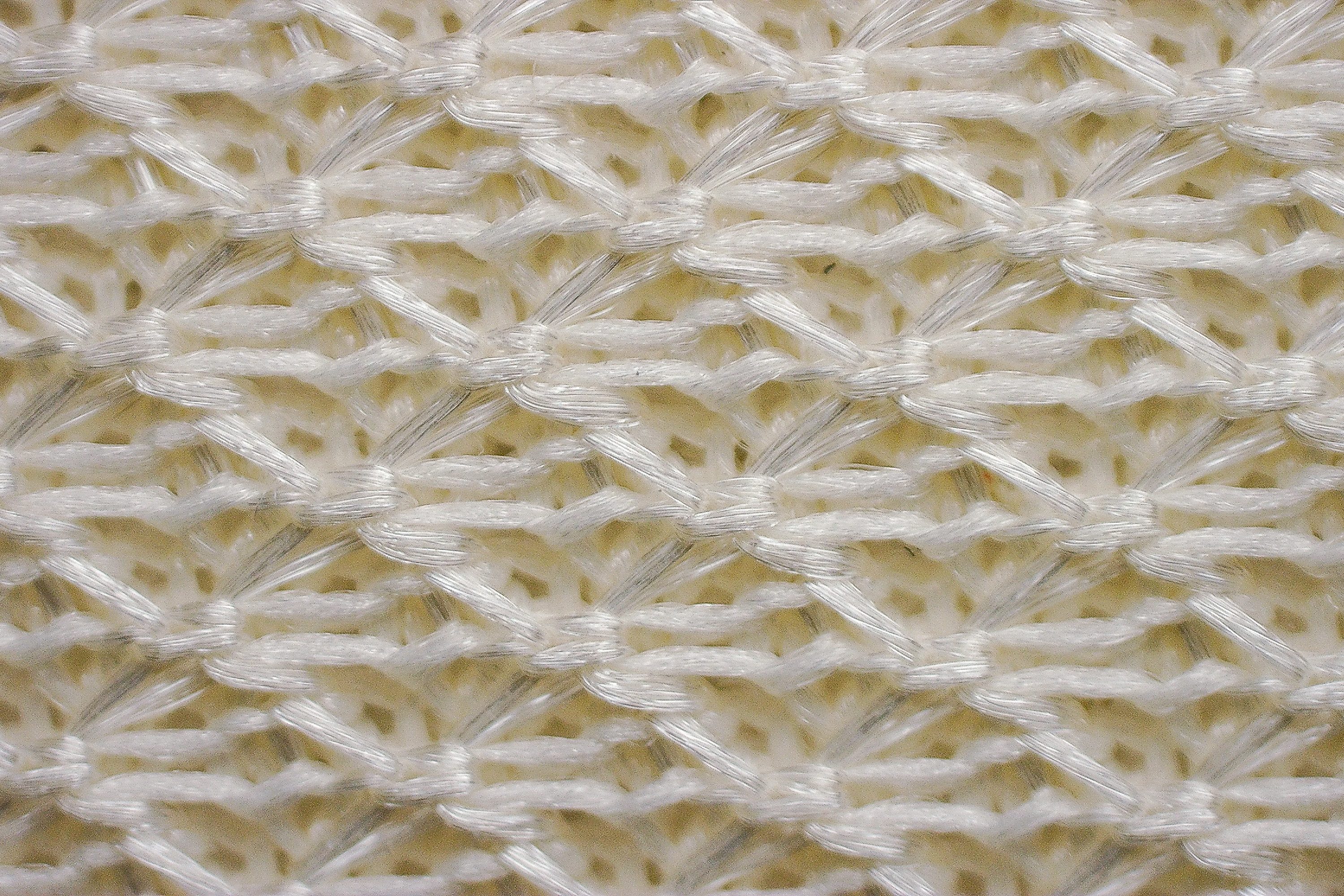
| 574 | 3 |
| Average | 3 |
Stability
Lateral stability test
New Balance was founded by an arch support specialist for a good reason. Stability or support is never an issue in sneakers from this brand.
As you can see in the video, our heel remains firmly planted on the ground as we attempt to shift the foot side-to-side. Let's have a look at the factors contributing to this in the sections below.
Torsional rigidity
First and foremost, there is a lot of stiffness in the shoe's platform. Twisting it sideways in our manual test, we could feel a great deal of resistance from the firm sole.
This led us to give this NB shoe a solid 4 out of 5 for torsional rigidity.
Stiffer shoes like this have a much smaller chance of letting your ankle roll over to the side. An extreme opposite case would be the Adidas 4DFWD 2.
| 574 | 4 |
| Average | 3.6 |
Heel counter stiffness
The NB 574 takes really good care of your ankles. With double overlays and a plastic ENCAP at the bottom of the heel, we felt very securely held at the rearfoot.
Between 1 and 5, we rated the 574's heel counter stiffness as 3. It is not the stiffest but structured enough for sure.
| 574 | 3 |
| Average | 3.2 |
Midsole width - forefoot
A stable platform wouldn't be complete without a nice and wide base. And the 574 scores high here too!
At the widest part of the forefoot, our caliper measured 114.3 mm, which is a whole centimeter wider than other classic sneakers like the Reebok Classic Leather (103.3 mm).
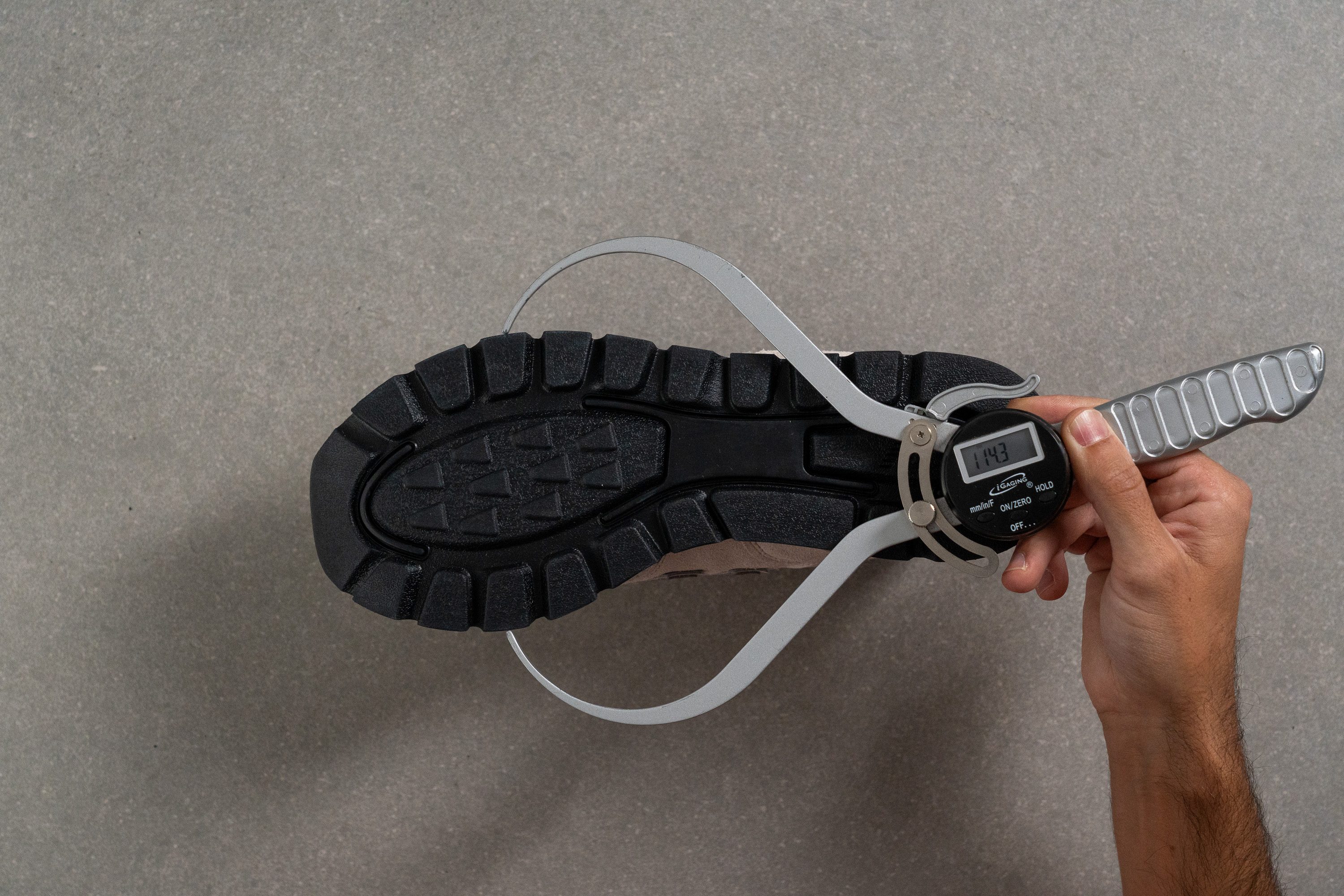
| 574 | 114.3 mm |
| Average | 108.9 mm |
Midsole width - heel
This NB shoe also proves to be fairly wide in the heel. We got 80.2 mm in the widest part of the sole, which is also on the wide side of the sneaker spectrum.
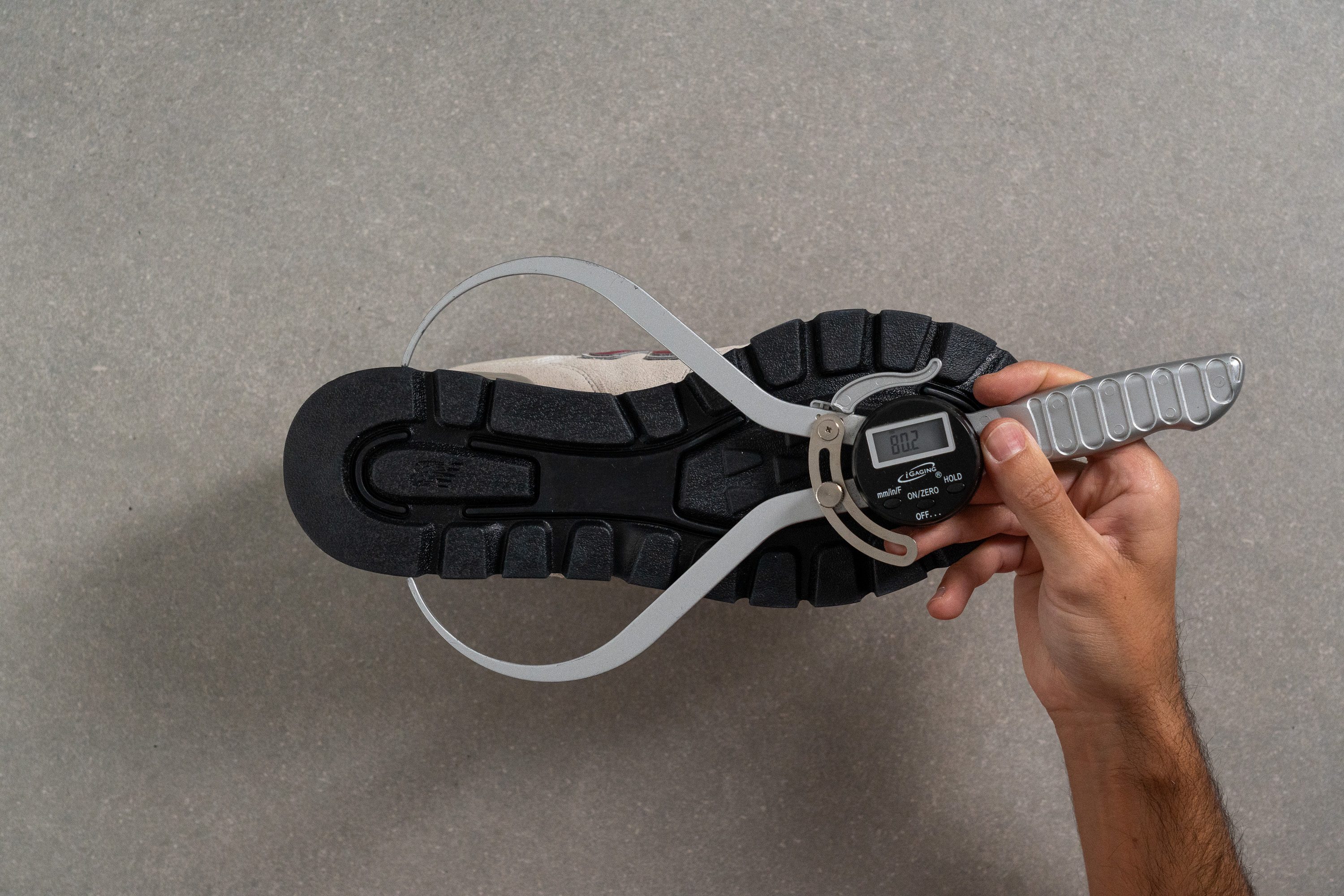
| 574 | 80.2 mm |
| Average | 84.0 mm |
Durability
Leather/Suede quality
When we take a closer look at the quality of materials on the NB 574, it actually becomes easier to forgive the lack of breathability. For a $90 shoe, we were impressed!
Equipped with a butane torch and a leather scratch awl, we tested the genuineness of materials in various parts of the upper. Our main point of interest was of course the suede. And it turned out to be real! Unlike the synthetic heel panel and the "N" logo, the suede didn't catch fire and stood up to the awl too.
| 574 | Real suede |
Toebox durability
The 574 did its wearers a huge favor by adding a very wide suede overlay on the toebox. It does a fantastic job of protecting the mesh layer underneath.
We can easily prove it in our durability test that involves a Dremel. Holding the tool against the suede at a consistent speed (10K RPM) and force (3.2N), we only got a small dimple!
Such amazing wear resistance earned the 574 a high score for toebox durability. On a 1-5 scale, where 5 is the most durable, we gave it a 4.
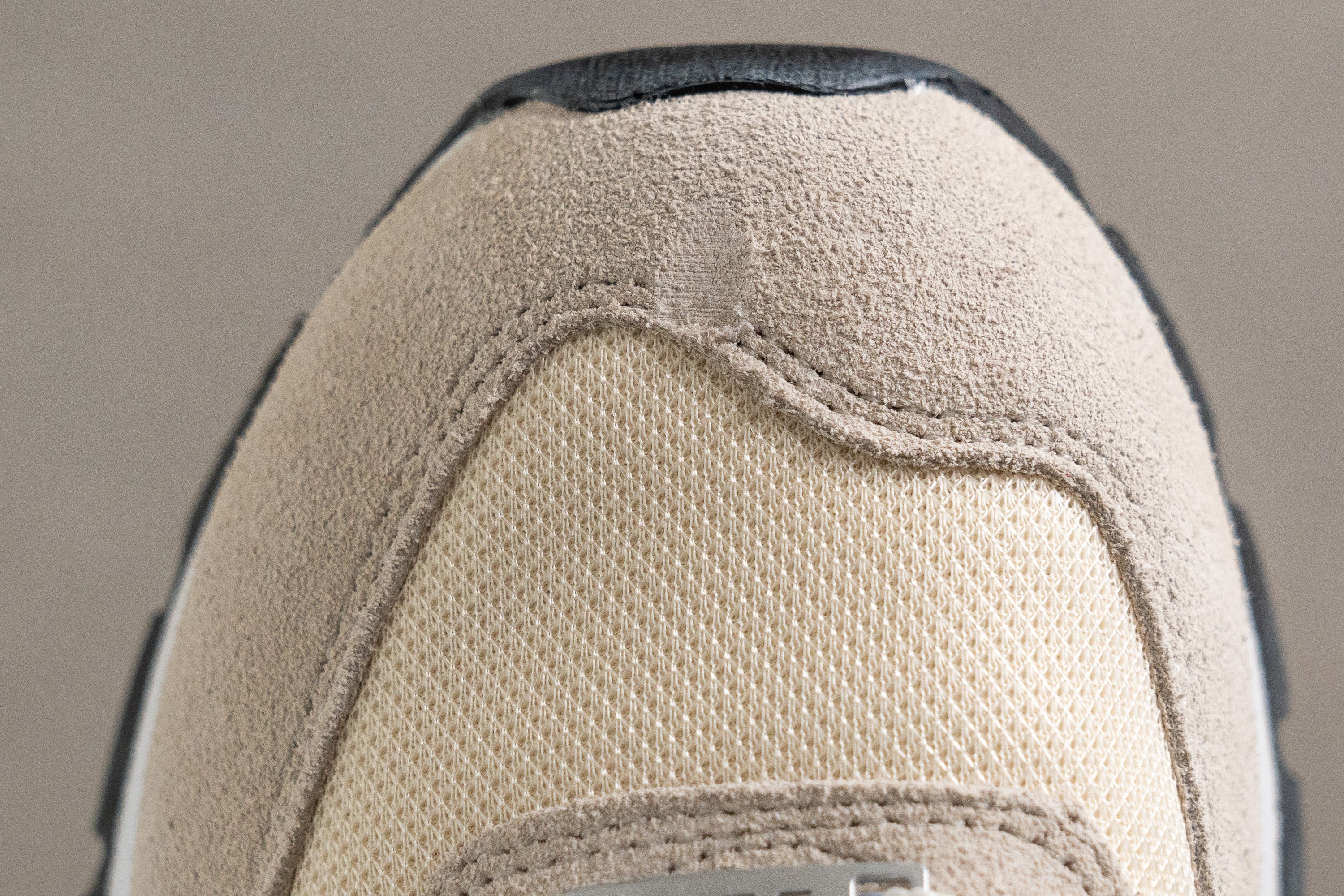
| 574 | 4 |
| Average | 3.7 |
Heel padding durability
Inside, the 574 is lined with a plush and comfy fabric lining. That one should be easy to tear, right? Right?
Well, apparently, our Dremel struggled with that! After 4 seconds of drilling the fabric, the damage was really minor compared to what we usually see in sneakers.
On a 1-5 scale, we rated the heel padding durability with a high score of 4.
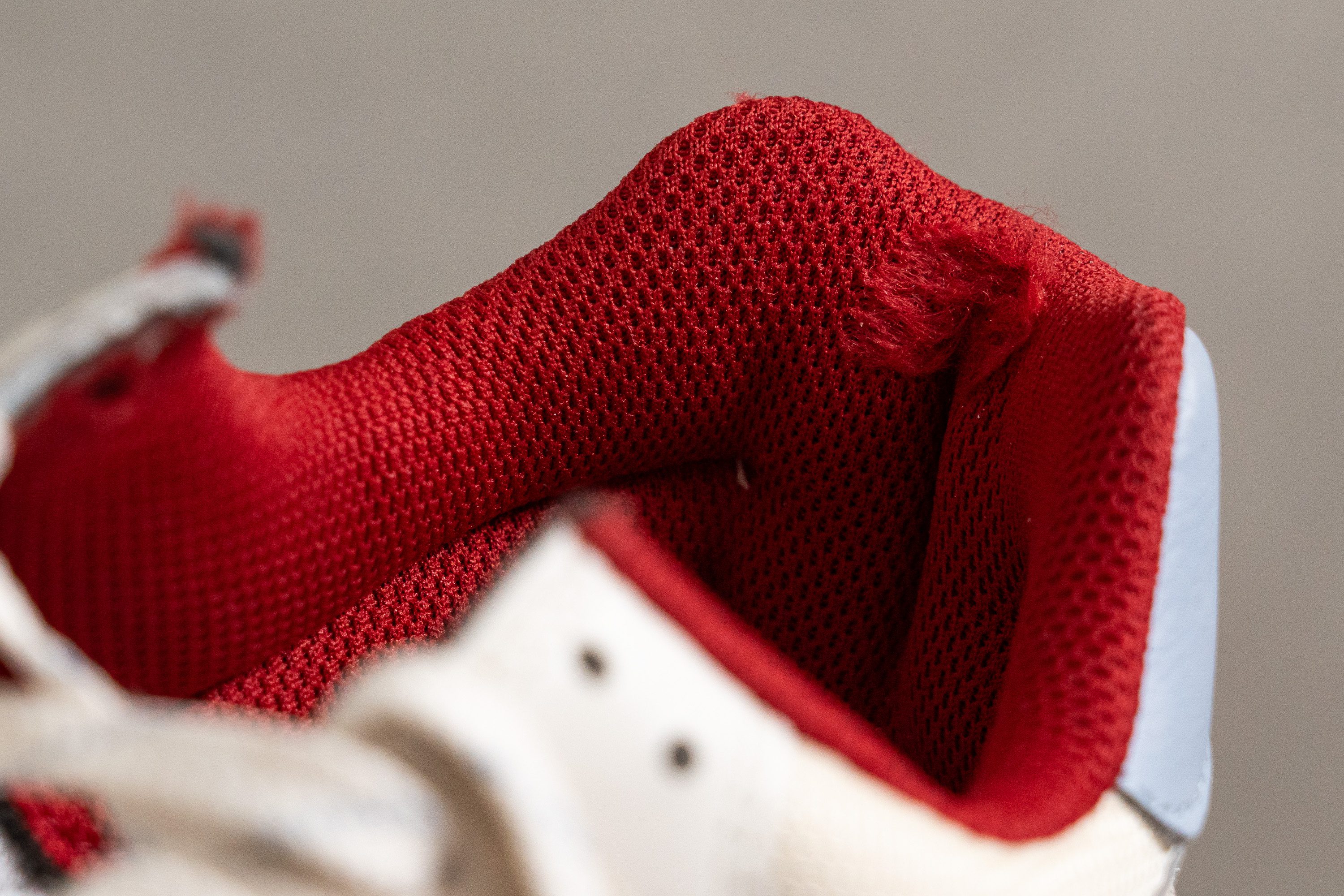
Great news for those of us who often develop holes in this part of a shoe!
| 574 | 4 |
| Average | 3.2 |
Outsole hardness
A rugged, massive outsole is 574's signature. But is it just as sturdy as it looks? Hell, yeah!
To begin with, we measured the hardness of that rubber at 83.1 HC. This is not much harder than the average of sneakers but it's a good start.
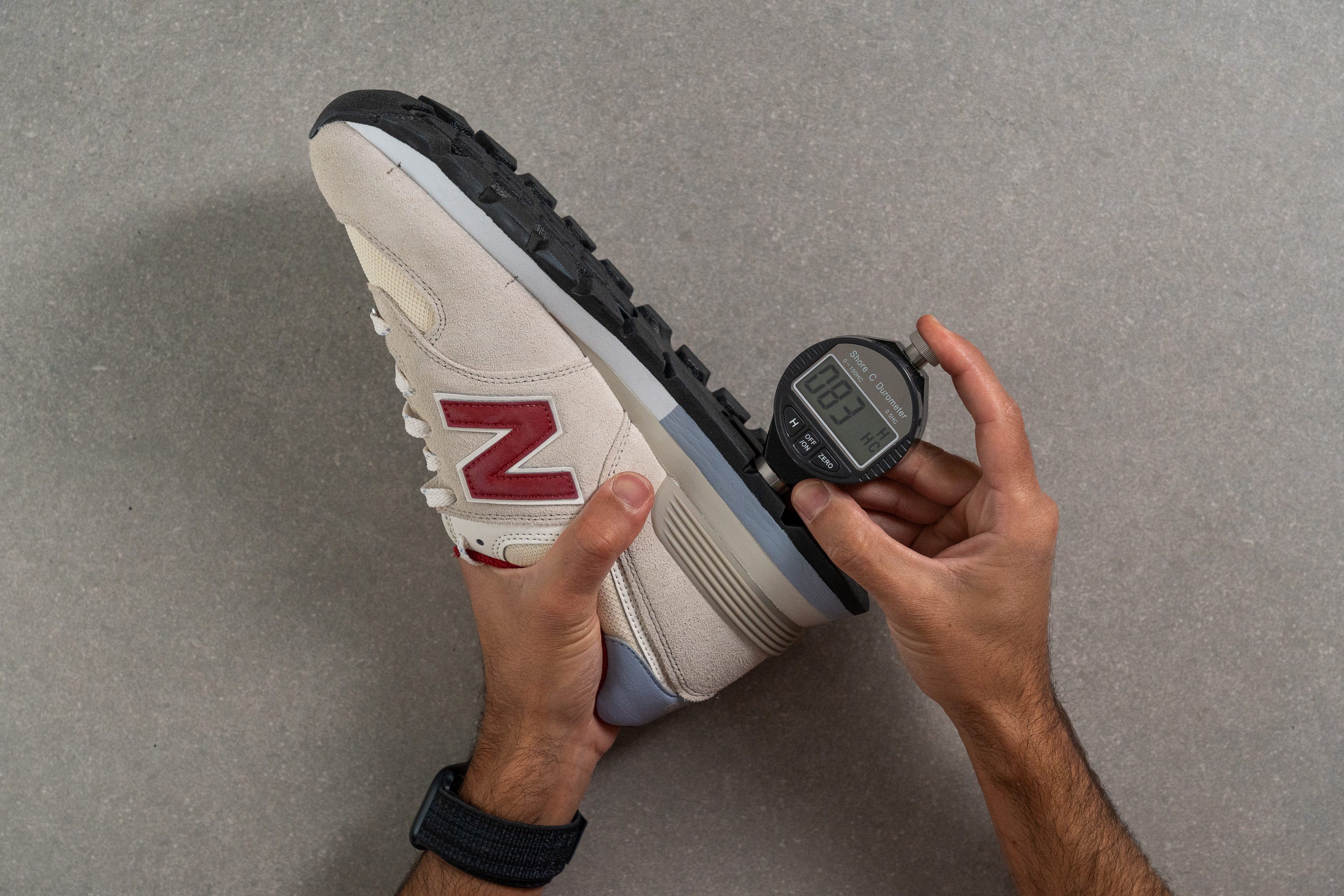
| 574 | 83.1 HC |
| Average | 85.7 HC |
Outsole durability
The shoe's outsole revealed its true nature in our demanding Dremel test. And it's a BEAST!
Drilling through the rubber for a good 22 seconds at a high speed of 10K RPM, it just couldn't be bothered!
According to our tread gauge, the depth of the dent is a mere 0.5 mm! For reference, most sneakers end up with 1 to 1.5 mm of damage (like the Adidas Gazelle below).
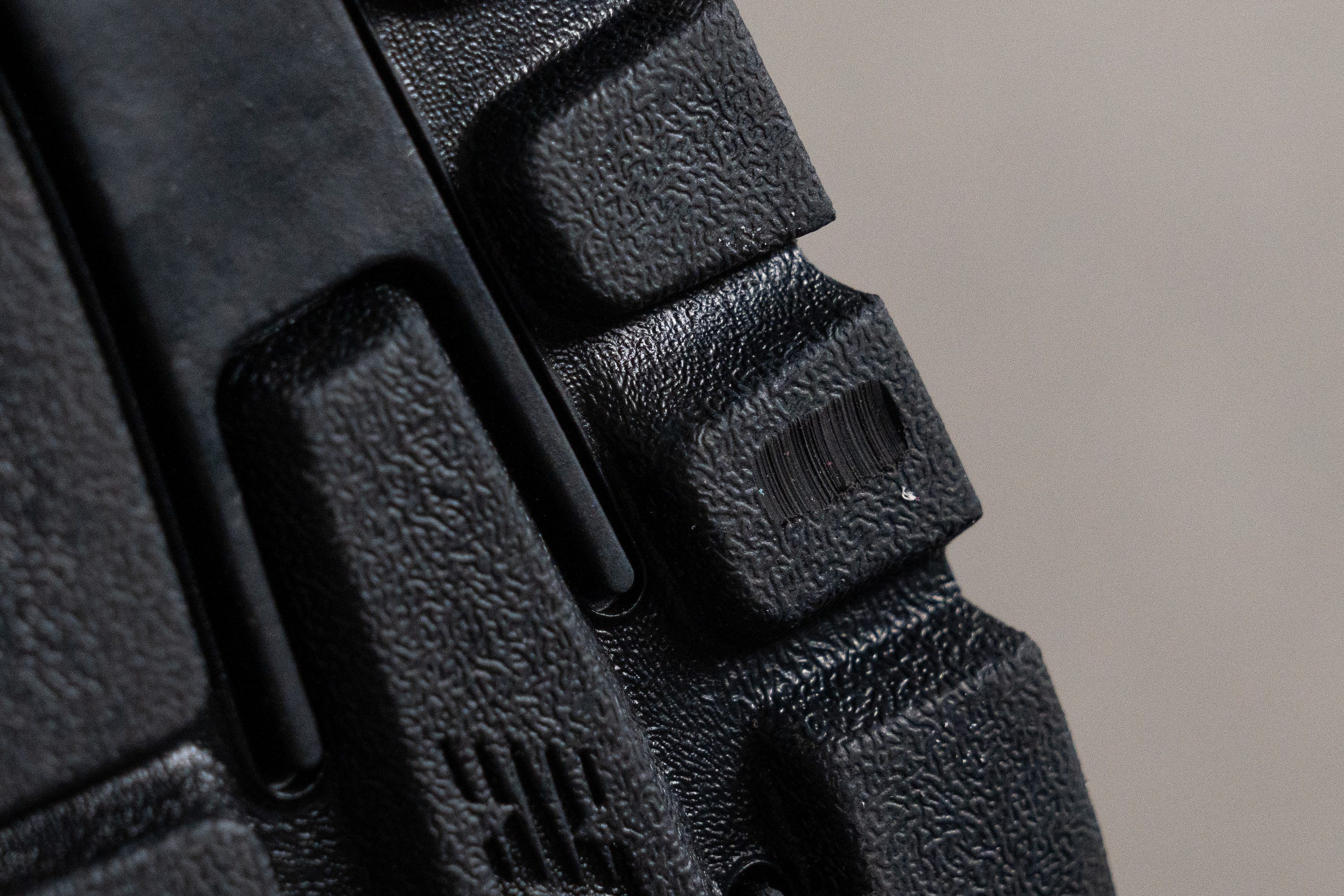
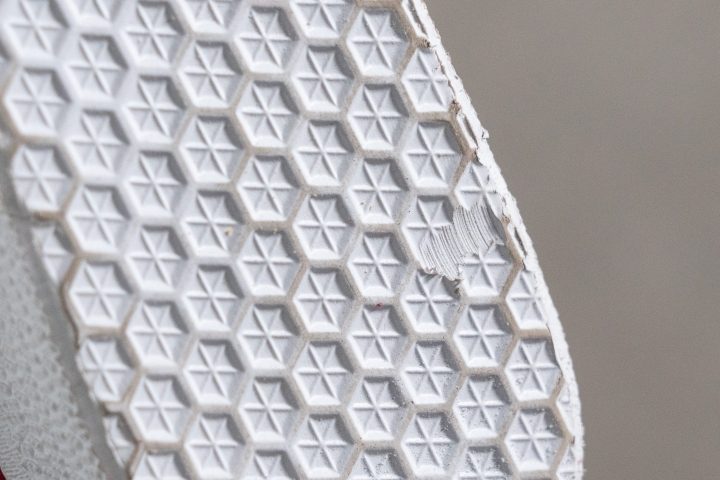
| 574 | 0.5 mm |
| Average | 1.1 mm |
Outsole thickness
But New Balance didn't stop there. The brand decided that a few millimeters of rubber was not convincing enough and packed as much as 8.2 mm into the 574!
This is one of the thickest rubber outsoles we've ever seen on a sneaker! It is also pretty aggressively lugged and is ready to outlast many other sneakers on the market. Especially, in its price range!
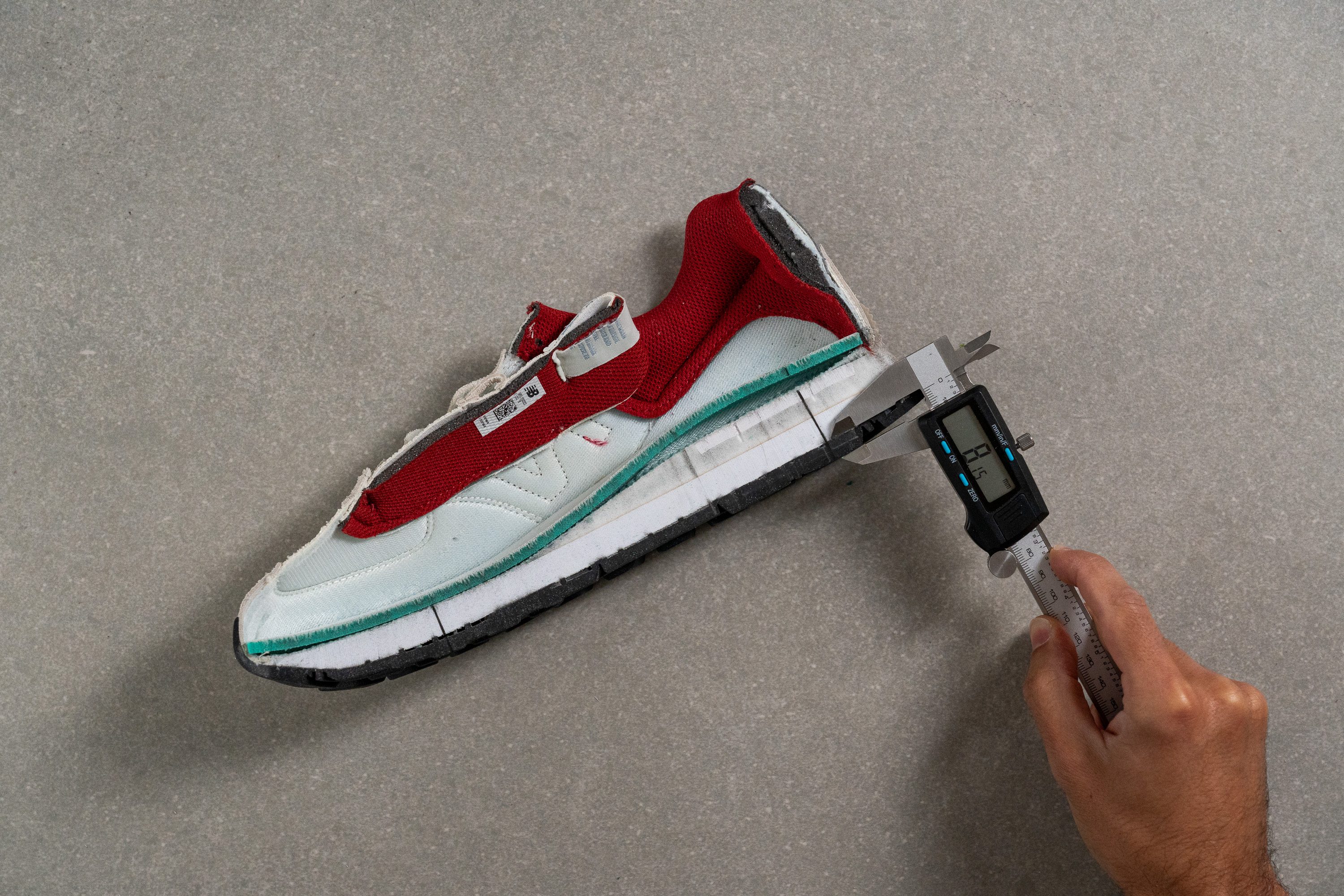
| 574 | 8.2 mm |
| Average | 5.3 mm |
Misc
Insole thickness
Completing the shoe's cushioning ensemble is a fairly padded insole. Being 4.7 mm thick, it is within the normal range for sneakers.

| 574 | 4.7 mm |
| Average | 5.1 mm |
Removable insole
Because New Balance started out as an insole company, they know how to make these inserts right. We enjoyed the 574's stock insole but if you need your own orthotic, it can be swapped easily.
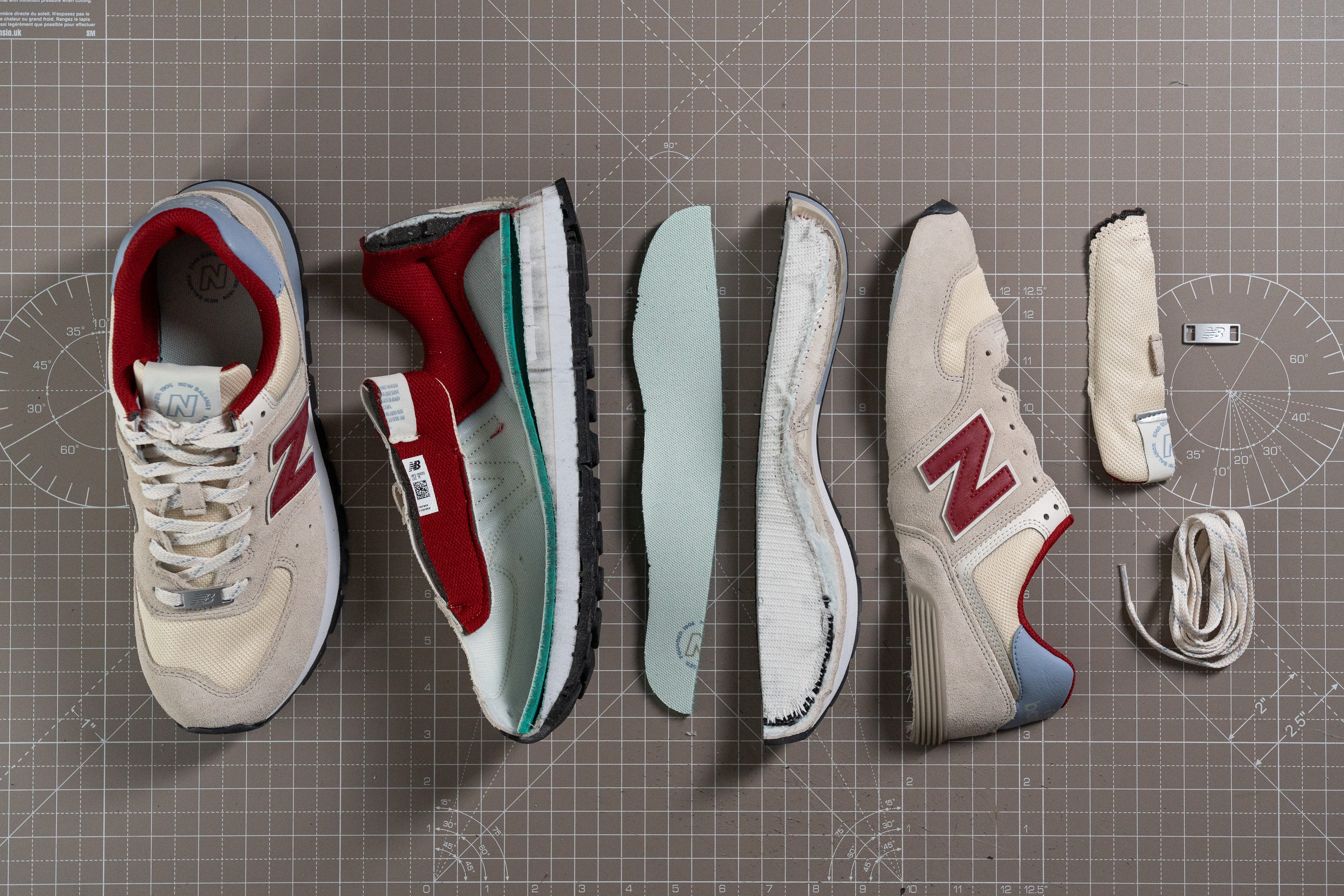
| 574 | Yes |
Reflective elements
No shining in the dark.
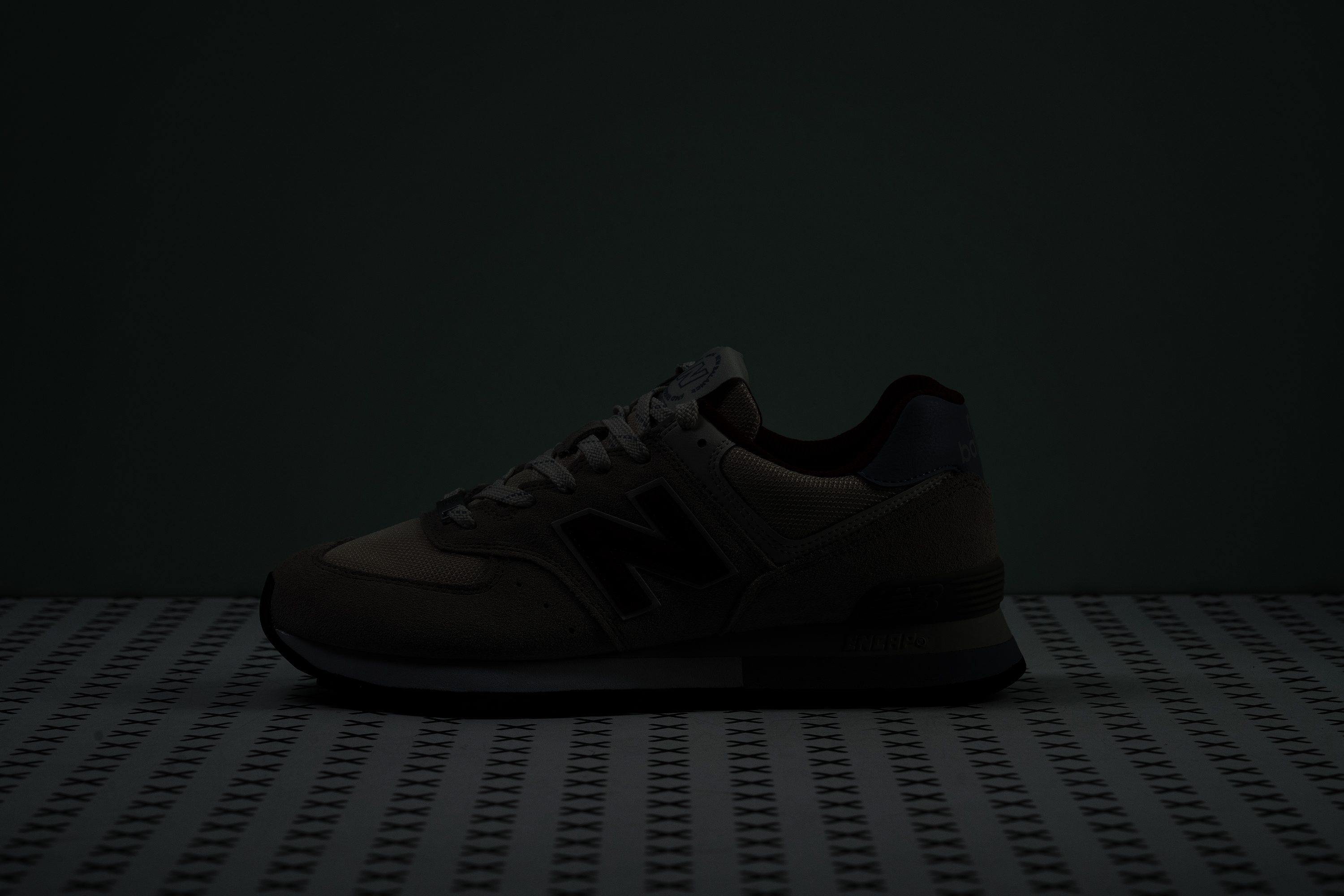
| 574 | No |
Tongue padding
Measuring the tongue padding, our caliper returned 4.6 mm.
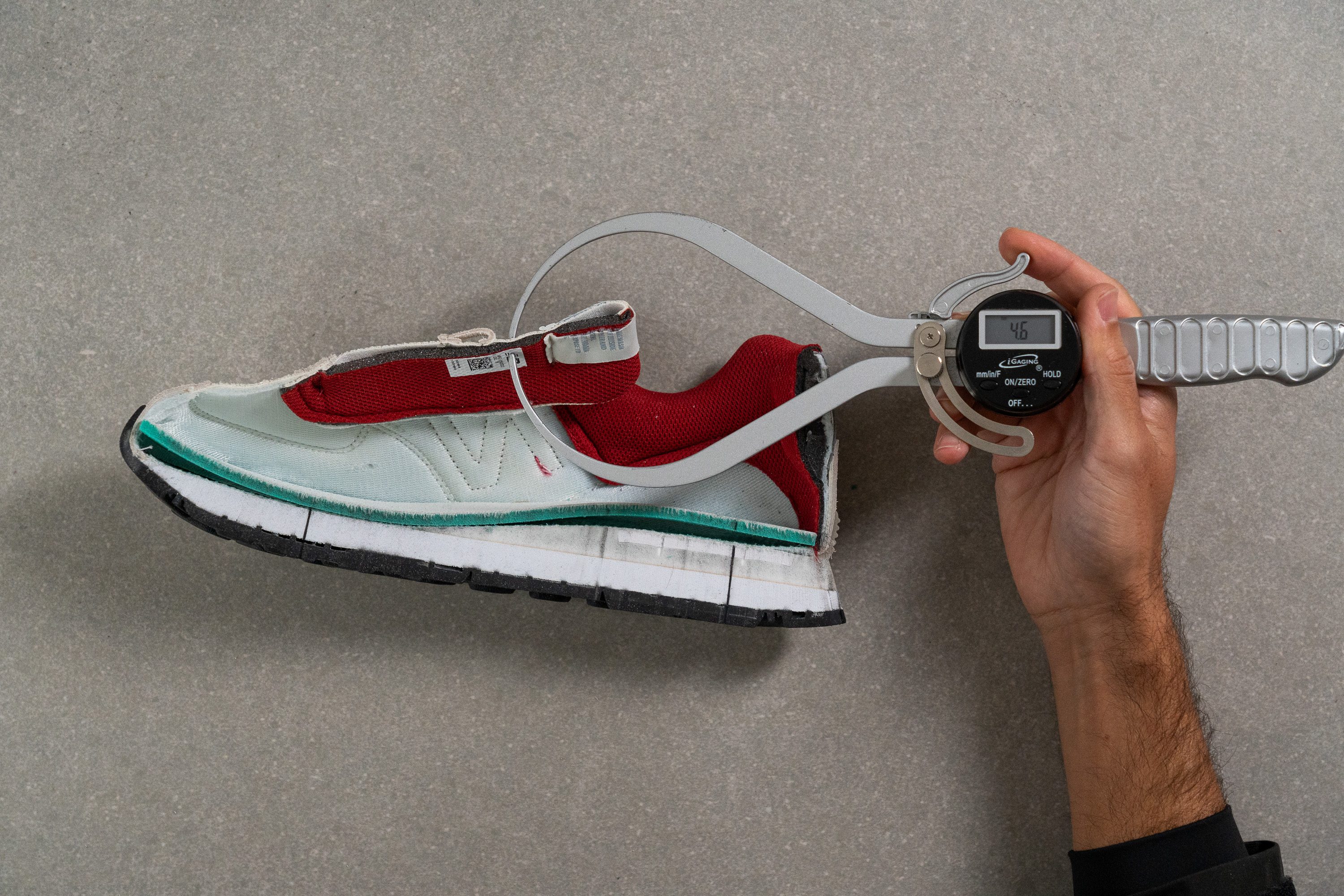
Even though it is about the same as average, we felt a little bit of lace pressure through it, especially when cinched tightly.
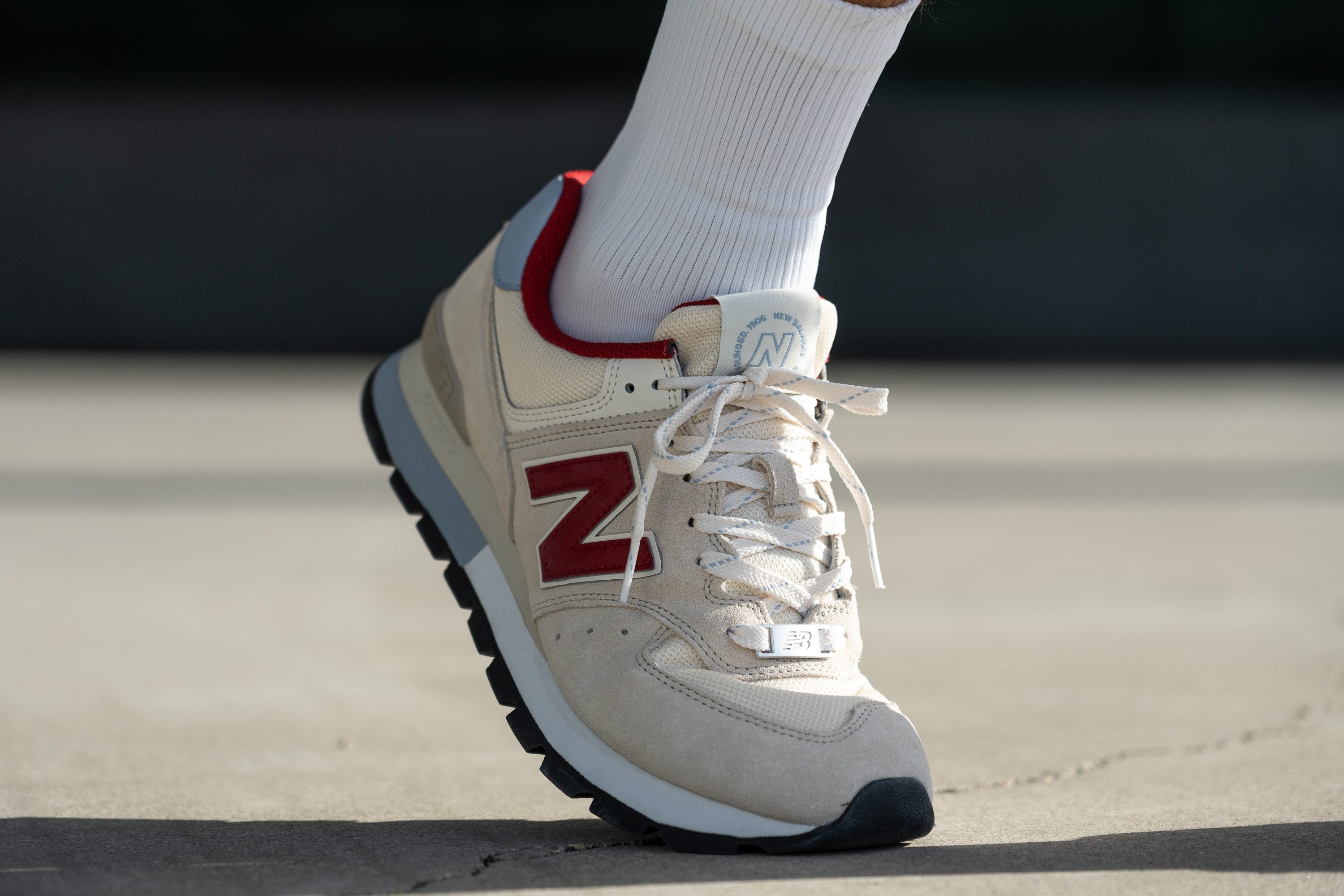
| 574 | 4.6 mm |
| Average | 9.6 mm |
Tongue: gusset type
The tongue doesn't have any gussets (attachments) on the sides. Unfortunately, this resulted in slight shifting of the tongue sideways in our case.

| 574 | None |
Heel tab
No heel tab at the back but we didn't find it a necessity in the 574.
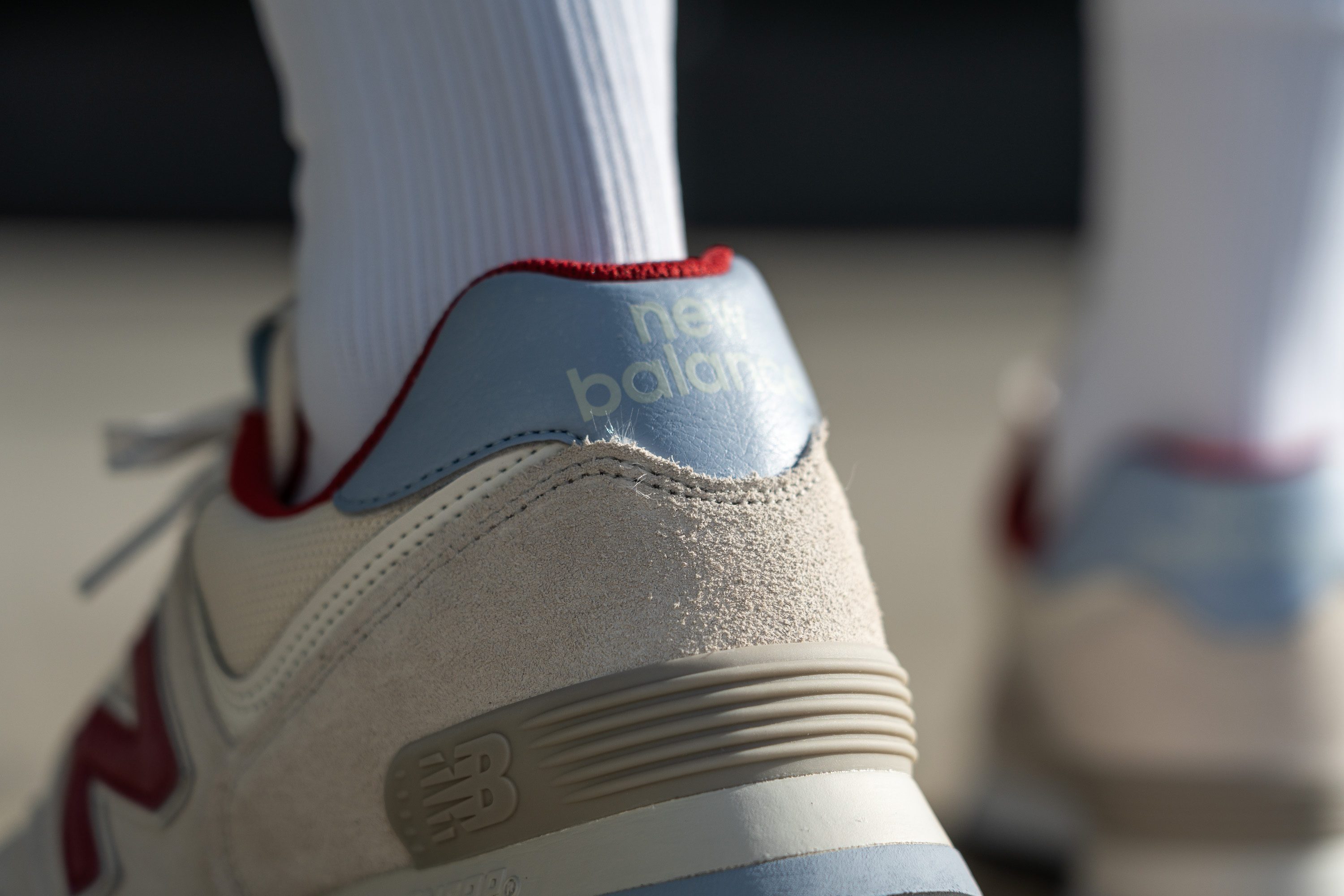
| 574 | None |
Style
In 1988, New Balance released the 574 as an advanced running shoe with a notable design. This iteration was a hybrid that blended the best details of New Balance's well-known running kicks, namely the New Balance 575 and 576 models.
The shoe also carried the famous ENCAP cushioning system, responsible for comfort and protection.
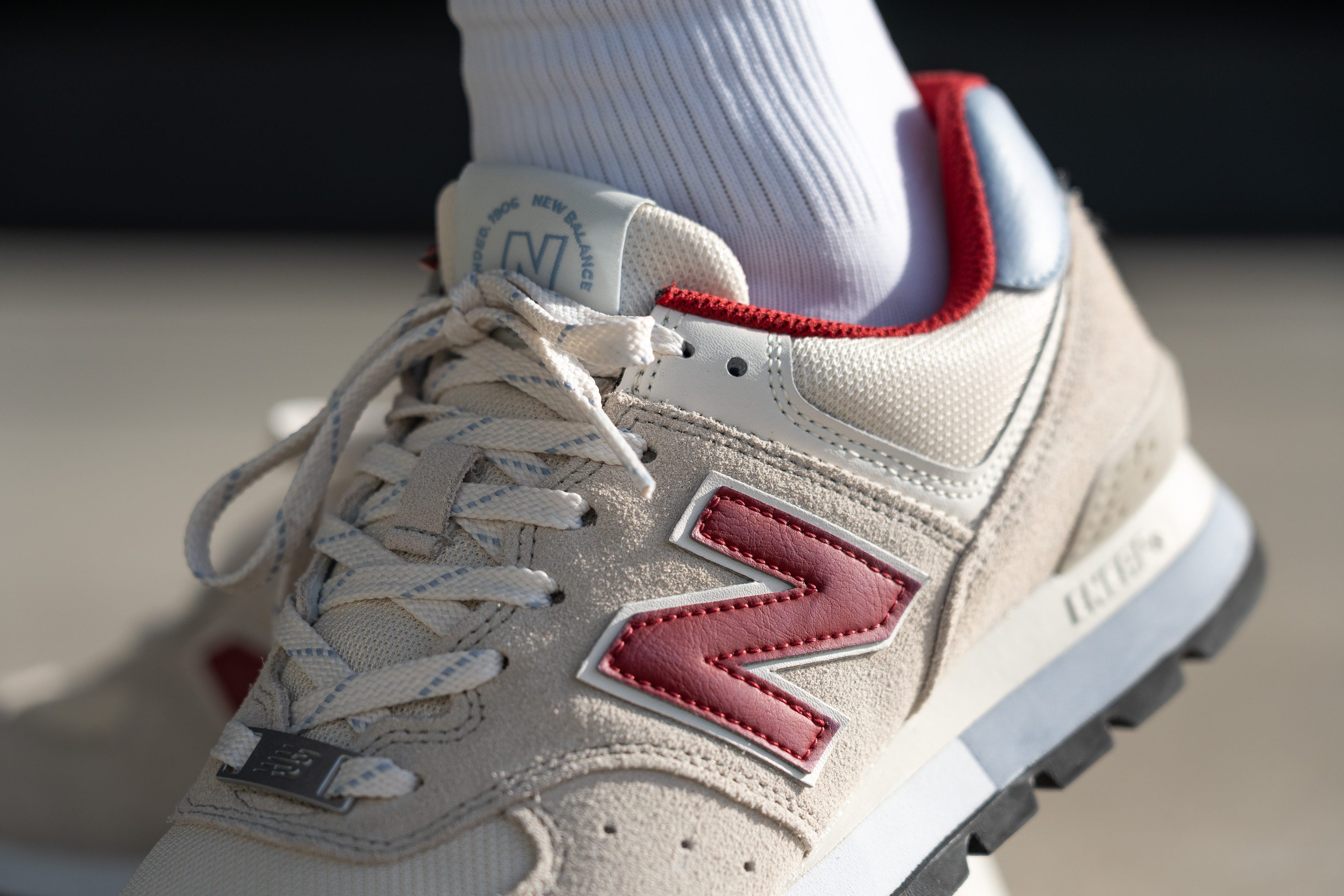
Ever since then, the 574 has undoubtedly become one of the brand's most iconic pairs in sneaker history. And even though it can be lost in the shadow of much more hyped releases like NB 550, the 9060, and the 2002R, it still holds its place as a timeless silhouette on the shelves of New Balance.
Especially for its unbelievably affordable price tag!

